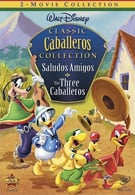Some Disney animated movies in recent years have taken a beating as being unworthy of the legacy of Walt Disney. However, two animated movies created under Walt’s supervision during World War II, Saludos Amigos and The Three Caballeros, show that he wasn’t always at the top of his game. The two related films have been released on one pretty average DVD. Saludos Amigos, released in 1942, and The Three Caballeros, released in 1944, have a few things in common. Both are relatively short animated films that are set in Latin American. Both feature Disney second banana Donald Duck, although not exclusively. Both ignore a storyline in favor of short segments that are often only loosely related in style, tone, and subject matter. Finally, both rank near the bottom of the animated projects overseen by Walt Disney himself, but have their charms.
Walt Disney was asked by the U.S. Government in 1942 to do something to help strengthen relations with Latin America during WWII. Saludos Amigos, which clocks in at a brisk 42 minutes, features a 16mm documentary of Disney and a team of his artists and musicians heading down to South America and visiting counties including Brazil and Argentina. They are shown sketching, drawing, and soaking up the local color, giving us a view of South America in the 1940’s.
The supposed inspiration from this trip takes the form of four animated shorts. Donald Duck is a tourist visiting Lake Titicaca and, apart from his location, it’s a pretty standard Donald short. A short about a young anthropomorphic airplane that delivers the mail is, likewise, much like lots of other animated shorts except his stops are in small South American cities rather than small U.S. Towns. Then Goofy shows up to do his usual “this is how a (fill in the blank) works.” In this case he’s a gaucho. Finally, Donald returns to meet José Carioca, a cigar smoking Brazilian parrot who introduces Donald to Samba music.
The shorts are not particularly strong, but they are solid efforts and the documentary interludes of Disney and his group shows a lot of nice scenery. Ultimately, though, the lack of any sort of cohesive story, the brevity of the overall film, and the fact that, with the exception of the last short, the cartoons don’t give you much of sense of South America, it’s not very impressive.
It’s a little more impressive than The Three Caballeros, though. The film, though longer at 71 minutes, has a real scraping of the bottom of the barrel feel. This time the plot device is Donald Duck getting presents from “his friends in Latin America.” The first present is a movie and allows the showing of two shorts, one about a penguin who wants to move someplace warm and the other about a boy with a flying donkey.
As should be clear from the subject matter of the first two segments, there is really nothing tying these shorts together. Donald’s friend from Saludos Amigos, José Carioca, shows up again and the duo step into books that become the South American locations. This leads to another Samba dance with an odd mix of live action and animation and one scene where to male dancers turn into roosters having a fight. It’s a strange sequence that will likely have you say “huh, uh, interesting.”
The rest of the film moves in this same direction with the addition of a Mexican rooster named Panchito Pistoles, who leads several segments focused on Mexico. Most of this section involves Donald hitting on the live action women he sees. The animation runs the gamut from static animated drawings, probably by Mary Blair, to almost psychadelic sections that bring to mind Pooh’s Heffalumps and other trippy Disney freak outs.
Your Daily Blend of Entertainment News
The lack of any cohesion in the story segments (there are seven) is not quite as jarring in this movie as the wildly different animation styles. Some of it is quite good and interesting, but it jumps around so much and varies so widely, it doesn’t feel comfortable. There is some decent Latin American music in both movies.
Some allowances need to be made for the impact of WWII on these films and the resources available to the Disney studio. Still, these movies rank nowhere near the quality and interest of the full length cohesive feature films released just before these two movies and during the 1950’s. They do give an opportuntity to introduce a child with little sense of the world outside the U.S. a way to see South America and Mexico. Other than that, they are just ho-hum. Since both movies are fairly short, especially Saludos Amigos, putting them on the same disc makes sense and is a better value than either alone. That said, while the print of Saludos Amigos isn’t bad, The Three Caballeros does not look good at all. Especially on an HDTV, the film has lots of scratches and a bland overall appearance. It doesn’t seem like Disney took particularly good care of the film and then put no effort into restoration. The presentation is 1.33 to 1, not widescreen, so if you have a widescreen TV, you will get black bars on each side of the picture.
The extras are nothing special and it’s clear that rather than give these two minor films a big release, Disney is just tossing them out there as something not seen recently and able to fill up the coffers a bit. There is a 33 minute documentary called “South of the Border.” It is basically the same type of 16mm footage used in Saludos Amigos of Walt Disney and his team of artists and animators in South America, just without the animated shorts. It doesn’t duplicate what is in the film, but it was obviously shot at the same time and functions more like a companion piece. It’s really an old-fashioned travel documentary, with the sights of Brazil, Chile, etc. taking precedence over the animators. It’s not the best thing on this disc, but it’s pretty enjoyable. It’s also fun to see film of a fairly young Walt Disney who is mostly remembered on film and television when he was middle aged man or older.
There is a really short interview with Walt Disney talking about the two films. He doesn’t have much to say, since the whole thing lasts about 90 seconds, but he does cover the U.S. Government’s request that he do some goodwill projects during World War II. The interview is undated, but it’s obviously the same one that many of us have seen where Disney talks about how he came up with the idea for Disneyland. This is another part of that same interview and seeing a different segment is interesting, albeit brief.
Finally, there are two Donald Duck cartoons, each about eight minutes long. I have never been a huge Donald fan; something about that voice has never been cute to me. That said, these are fun little shorts and when you add the sixteen minutes to the running time of the two films, you get almost two hours of animation. That’s not too bad.
If you don’t have either of these movies in your collection or have never seen them, a two-fer is not a bad way to go. This is a less than stellar release, but it’s not like these movies warrant individual special editions. Just realize what you are getting and you might enjoy these old animation segments and gain a new appreciation for South America; at least South America of the 1940’s.

